- Established 1982 -HOME: www.hiltonpond.org
THIS WEEK at HILTON POND Subscribe for free to our award-winning nature newsletter (Back to Preceding Week; on to Next Week) |
| A TRIO OF WINTER WOODPECKERS
Thanks to a cornucopia we faithfully provide, numerous backyard bird feeders at Hilton Pond Center bring a little excitement during damp, dark days of winter. Dawn to dusk, Carolina Chickadees zip in, grab a single sunflower seed, hurry off to a perch, crack the seed and eat it--then fly back in and repeat the sequence . . . over and over again. White-throated Sparrows, Brown Thrashers, and Mourning Doves are content to rummage through whatever seeds have fallen to the ground beneath feeders, while American Goldfinches pluck thistle seeds from a mesh sock dangling from a hickory branch. Suet attracts a surprising variety of avian diners, from Pine Warblers to Carolina Wrens, and Hermit Thrushes to Northern Cardinals.
All text, maps, charts & photos © Hilton Pond Center Every now again a raucous band of Blue Jays (above) bursts onto the scene outside the office window of the Center's old farmhouse, shrieking loudly as less aggressive competitors scatter into nearby shrubs. But even those jays are dominated by a Red-bellied Woodpecker pair that comes and goes at the feeders with impunity. The jaybirds are wise to depart, lest a red-bellied's sharply pointed one-inch bill peck on a jaybrain rather than wood.
All text, maps, charts & photos © Hilton Pond Center Those nearly ten-inch-long Red-bellied Woodpeckers (RBWO) are the largest of the Center's regularly occurring picids--i.e., members of the woodpecker Family Picidae that also includes tropical piculets and Old World Wrynecks. The image above reveals several things of interest about woodpeckers in general and red-bellieds in particular. For one, notice the long , pointed tail feathers pressed tightly against the seed feeder; these are extremely stiff and provide a stabilizing element--the third leg of a tripod completed by the woodpecker's two legs. Also visible is that long, straight bill adapted for chiseling into trees; Note also the Red-bellied Woodpecker has a series of alternative black and white strips on its dorsum, making it one of the "ladder-backed" woodpeckers. (Included in this informal group are several western species, plus the endangered Red-cockaded Woodpecker of southeastern states.) Our top photo of the Red-bellied Woodpecker doesn't show its reddish-orange underside--
All text, maps, charts & photos © Hilton Pond Center At least thrice as abundant as Red-bellied Woodpeckers at Hilton Pond Center is their pint-sized relative, the diminutive Downy Woodpecker (DOWO). This is the smallest picid in the eastern U.S., measuring a mere six inches or so, bill tip to tail tip. Like many woodpeckers, its standard attire is black and white with--at least in males--a touch of red. Among DOWO, the male (above) has a red spot on its nape, a mark is absent in females. (In spring, many recently fledged downies--especially young males--have red in the crown rather than on the nape. We wonder if this is a target spot that helps the parents see nestings in the dimly lit nest cavity.)
Even though Downy Woodpeckers are known to take up residence in boxes erected for bluebirds, the majority of these little chisel-bills excavate their own nest cavities in snags and broken branches of hardwood trees. Interestingly, a downy pair usually keeps a nest for just one breeding season, making it available the next year for everything from bluebirds to nuthatches to Southern Flying Squirrels. We've observed that scenario in exactly that order here at the Center. All text, maps, charts & photos © Hilton Pond Center Our third winter woodpecker at Hilton Pond is here ONLY during cold months, showing up most years in late October and departing by mid-March. We say "twice mis-named" because a sapsucker doesn't really suck sap--it laps it up with feather-edged tongues (the bill is not a straw)--and because the woodpecker's yellow underside is seldom seen as it clings tightly to tree trunks. (Another example--like the Red-bellied Woodpecker--of a bird being named by a museum taxonomist rather than a field ornithologist.) Sapsuckers are slow, methodical workers, spending their days drilling tree trunks with quarter-inch holes in distinctive horizontal rows (see photo above left). These wounds ooze sap, providing the bird with a dilute but nutritious source of carbohydrates during cold weather. (Such "sapsucker wells" are known to supplement diets of quite a few other birds, including warblers, kinglets, and Ruby-throated Hummingbirds.) We humans merely imitate the age-old skills of sapsuckers when we tap a maple tree to make sugary syrup.
All text, maps, charts & photos © Hilton Pond Center You'll notice in our first sapsucker image the bird displays crimson on both its head and throat; this makes it a male, because females do not have red throats. Most of the time, however, female YBSS show at least a little red in their forehead and crown (below left), making the black-capped one at this winter's suet feeder (above) rather unusual.
Two other points of interest in our photo just above of the female Yellow-bellied Sapsucker at the suet feeder: 1) A prominent white wing stripe characteristic of this species; and, Aside from the Yellow-bellied Sapsucker and Red-bellied and Downy Woodpeckers detailed above, four other picids have been observed and banded at Hilton Pond Center, but none were seen this winter--and all occur locally in relatively small numbers.
All text, maps, charts & photos © Hilton Pond Center Even though we've had just three kinds of woodpeckers at Hilton Pond Center this winter, any of the other four species listed above is liable to pop up at any moment. To encourage them to visit and stay, we put out bark butter during cold weather and suet year-round. (For summer months we opt for suet blocks formulated not to melt in heat of the sun.) Hang and maintain a suet cage or three and you, too, will likely attract woodpeckers to your own backyard. And if you leave a dead snag standing where it won't fall on your house, you might even get to watch a picid pair producing young. All text, maps, charts & photos © Hilton Pond Center
Checks also can be sent to Hilton Pond Center at: All contributions are tax-deductible on your Don't forget to scroll down for Nature Notes & Photos, |
|---|
|
"This Week at Hilton Pond" is written and photographed by Bill Hilton Jr., executive director of Hilton Pond Center for Piedmont Natural History
|
|
|
Please refer "This Week at Hilton Pond" to others by clicking on this button: |
|

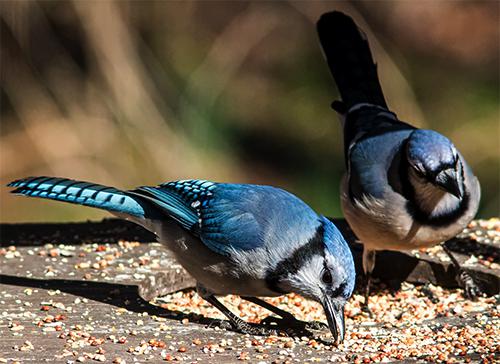
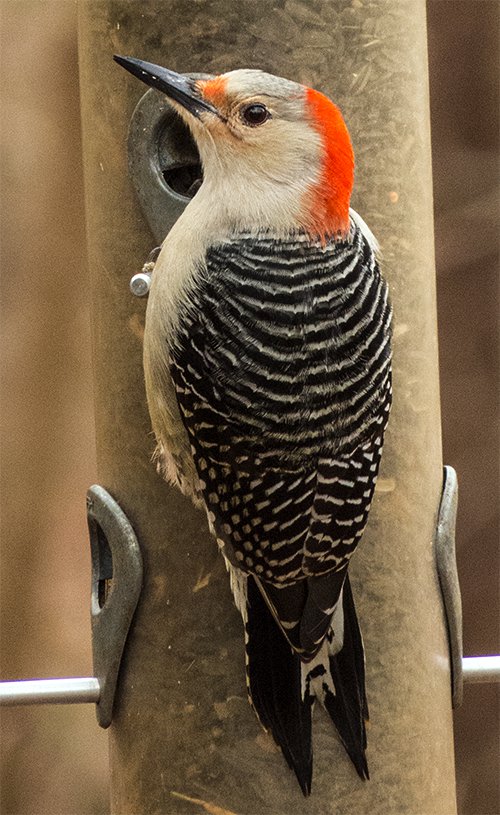
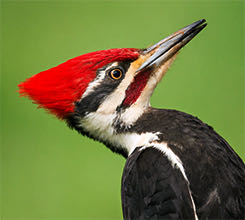 (We regret that much-bigger crow-sized Pileated Woodpeckers--male, at left--have appeared locally on only a half-dozen occasions in the past 39 years.)
(We regret that much-bigger crow-sized Pileated Woodpeckers--male, at left--have appeared locally on only a half-dozen occasions in the past 39 years.)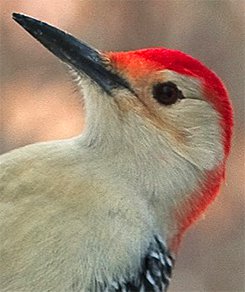 woodpeckers peck wood to extract beetle grubs and other insects and to excavate nest holes in dead snags.
woodpeckers peck wood to extract beetle grubs and other insects and to excavate nest holes in dead snags. 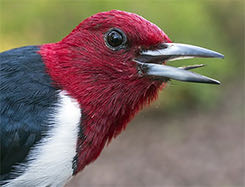 an attribute that isn't of much help since it is seldom visible in the field.
an attribute that isn't of much help since it is seldom visible in the field. 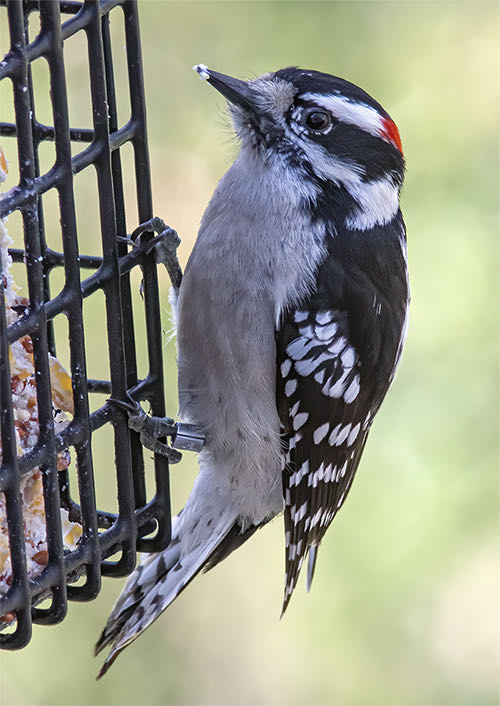
 It's easy to tell whether and adult downy is male or female because of the presence or absence of that red nape spot, but distinguishing this species from the somewhat larger and strikingly similar Hairy Woodpecker
It's easy to tell whether and adult downy is male or female because of the presence or absence of that red nape spot, but distinguishing this species from the somewhat larger and strikingly similar Hairy Woodpecker 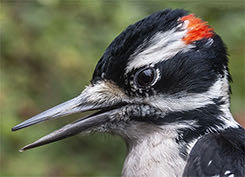 Although not 100% accurate, a better way to differentiate these two mimics is to look at their white outer tail feathers. As shown in our photo above of a DOWO at a suet feeder, the white feathers have black spots--a mark absent in nearly all HAWO. Unfortunately, these spots are not always easy to see from the back when a downy is against a tree trunk or feeder. This winter the
Although not 100% accurate, a better way to differentiate these two mimics is to look at their white outer tail feathers. As shown in our photo above of a DOWO at a suet feeder, the white feathers have black spots--a mark absent in nearly all HAWO. Unfortunately, these spots are not always easy to see from the back when a downy is against a tree trunk or feeder. This winter the 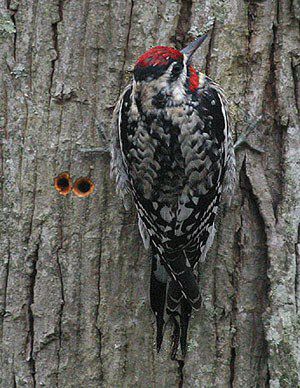 We know it has arrived when we hear its cat-like mewing--plus a slow series of soft taps in a gnarled old Pecan tree in the front yard of the
We know it has arrived when we hear its cat-like mewing--plus a slow series of soft taps in a gnarled old Pecan tree in the front yard of the 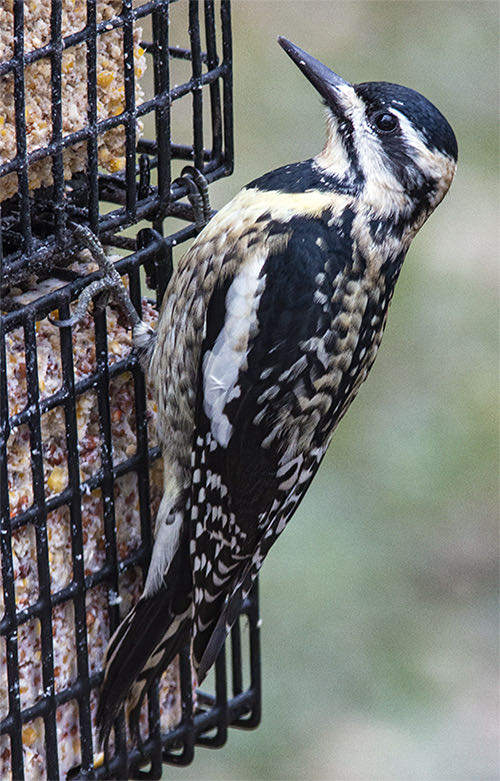
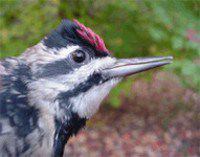 When we first observed this seemingly anomalous red-less female back in November 2019 we inquired of other banders who have more experience with Yellow-bellied Sapsuckers; we learned some researchers never capture females without red crowns and others band them up to a sixth of the time. There is some suspicion this plumage difference may be a geographic marker for certain sub-populations. The phenomenon is worthy of further study but might be difficult to confirm because many sapsuckers nest in remote areas of Canada and are observed primarily on their wintering grounds.
When we first observed this seemingly anomalous red-less female back in November 2019 we inquired of other banders who have more experience with Yellow-bellied Sapsuckers; we learned some researchers never capture females without red crowns and others band them up to a sixth of the time. There is some suspicion this plumage difference may be a geographic marker for certain sub-populations. The phenomenon is worthy of further study but might be difficult to confirm because many sapsuckers nest in remote areas of Canada and are observed primarily on their wintering grounds. 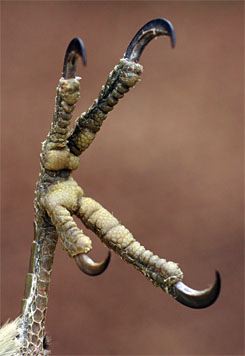 2) The way the bird is holding onto feeder wires. On the right foot two fore-claws cling to the wire, while the two hind toes are not visible. All woodpeckers have this zygodactyl foot configuration with two toes forward and two toes back
2) The way the bird is holding onto feeder wires. On the right foot two fore-claws cling to the wire, while the two hind toes are not visible. All woodpeckers have this zygodactyl foot configuration with two toes forward and two toes back  These absentees are the aforementioned Pileated, Hairy, and Red-headed Woodpeckers, and the ant-eating Northern Flicker
These absentees are the aforementioned Pileated, Hairy, and Red-headed Woodpeckers, and the ant-eating Northern Flicker 









 Oct 15 to Mar 15:
Oct 15 to Mar 15: